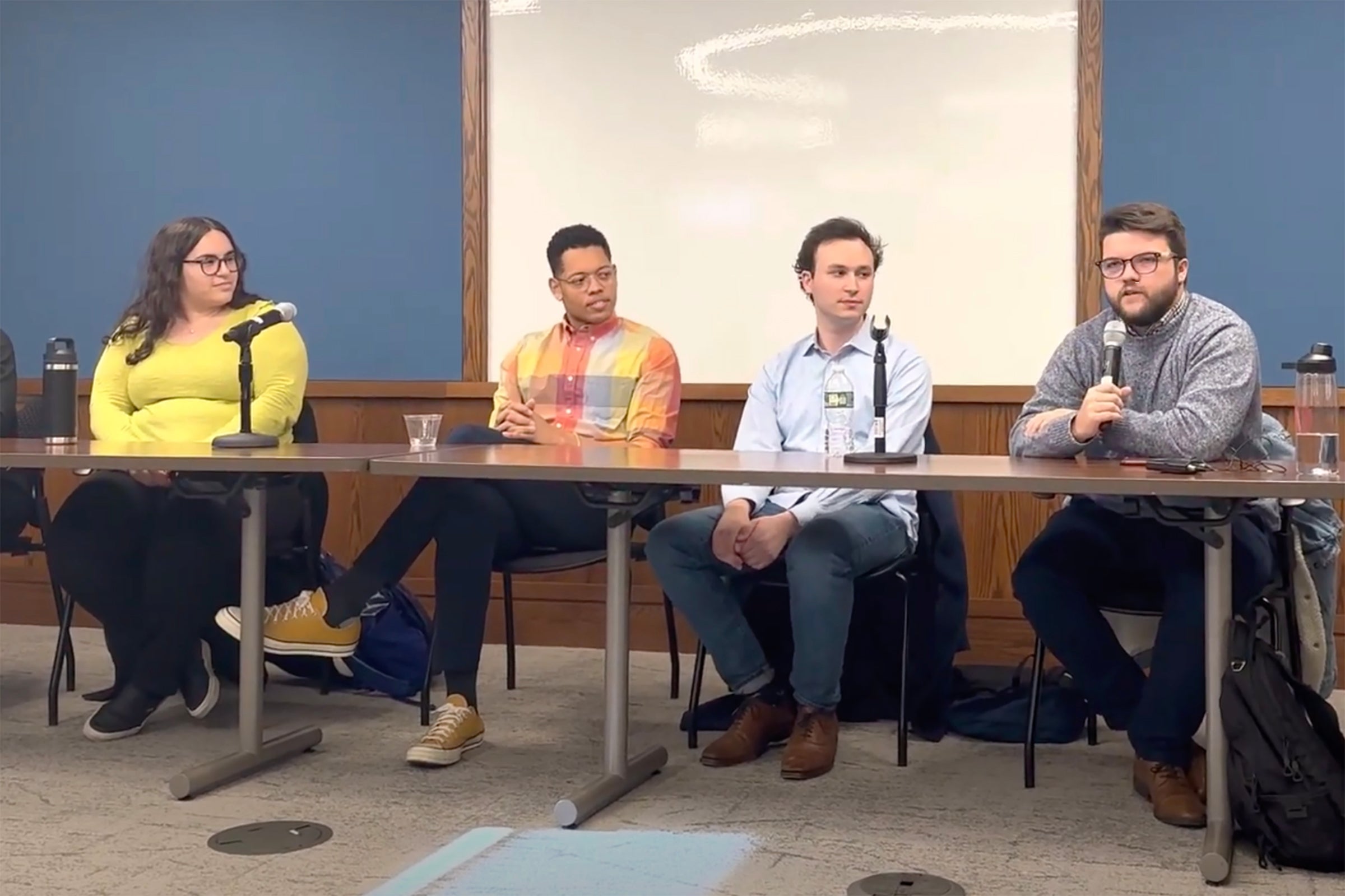By Olivia Klein

Within moments of arriving in Philadelphia in January, Robert Clinton ’24 and Charles Sonenclar ’24 — two Harvard Law students participating in the school’s Capital Punishment Clinic — dove into work on last-minute appeals in the cases of two defendants whose executions were scheduled within a month. The opportunity to take on two cases with life-or-death consequences came during a winter term placement with the Federal Public Defender Office’s Capital Habeas Unit of the Eastern District of Pennsylvania.
“It was really intense and really sad, but it was a great learning experience to be a part of that,” said Sonenclar.
It is also a perfect example of the kind of learning and service in which students regularly engage in the clinic — one of 32 programs at Harvard Law School in which the lawyers-in-training gain hands-on experience practicing law while serving clients who need their help.
At a recent event hosted by the Harvard Law School Library, Clinton and Sonenclar joined fellow students Kellen Dugan ’24, Natalie Leitman ’24 and clinic alumnus Fjora Arapi ’23 on a panel to discuss their experiences working with capital defense offices across the country.
Each of them arrived at the clinic armed with previous experiences on all sides of the criminal legal system, from prosecution work to state level capital appeals. The clinic’s director, Professor Carol Steiker ’86, further sparked their interest in the work in her first year reading group, Voices from the American Criminal Justice System.
In the clinic, students can choose to work with a variety of organizations across the country, including work on state and federal habeas petitions — challenges to the sentences that courts have handed down to defendants — at state government organizations or with private attorneys.
“One of the great things about this clinic is that before you start your hands-on work, you take a seminar with Professor Steiker, who’s an expert in this work,” said Clinton. “The cool thing about the clinic experience was that we got to expand beyond that canon of cases that we learned about in the seminar.”
In Austin, Texas, Dugan and Leitman worked at the Office of Capital and Forensic Writs, a state public defender office. While they were at the placement, two month-long hearings were happening — unusual for an office whose typical work consists of writing lengthy applications for habeas. While working on appeals for an upcoming execution case, they also jumped in to help attorneys who were a part of the hearings with any last-minute documents and research they needed.
Each student left their placement with a host of examples of the legal challenges and procedural hurdles that arise in capital case work. From uncovering voir dire faults — errors in the process by which juries were seated — to examining racist language in past court transcripts, the students saw firsthand the frustrating miscarriages of justice that frequently go unchallenged.
The accompanying emotional gravity of capital punishment work has remained with the students.
“It’s really tough,” said Sonenclar. “Robert and I were there when two of our clients were executed, and I was glad we had each other to talk to about it with and didn’t go through that experience alone.”
Clinton echoed the sentiment: “Law school before this clinic felt removed from real life. This experience was the other extreme of the spectrum; we were working on cases of real people whose lives were on the line and whose lives were ultimately lost. It was great to see lawyers working for good, to save people’s lives in a literal sense and to put all of the things we had learned into practice. I like being able to apply that learning, but I wish that it wasn’t always so hopeless. A lot of the procedural issues get in the way of saving lives, and that’s really difficult. Regardless, it’s good to say, ‘I was there, and I tried to help.’”
Dugan and Leitman also experienced the loss of a client this March, while working remotely for their placement from Cambridge.
“You go into this work with your eyes as open as they can be, but it’s hard to have them completely open until something like that happens,” Dugan reflected. “It’s hard to describe. It was a jarring experience to go through. Having a community to go through that with was important, so I was glad that Natalie and I had each other. It’s definitely very taxing work, but it should be — you don’t want to ever reach a point where you’ve become numb to the hurt that happens.”
“When I feel drained and emotionally taxed from this work, I try to channel that back into the work,” said Leitman. “I channel that anger and those emotions back into the work, and that’s the best that I can do.”
Despite the challenges, the students are more interested than ever in carrying on with capital punishment work in the future.
“The need for competent, careful, and caring attorneys at the capital stage is still so high,” said Dugan. “I’ve never been in a situation where my work has mattered more than in this clinic. The stakes have never been higher — which is cool to think about. And also scary.”
The event was hosted in conjunction with the Library’s related exhibit, Visualizing Capital Punishment: Spectacle, Shame, and Sympathy, open to HUID holders in Langdell Hall weekdays 9-5, and open to all online.
Watch the panel here:
Filed in: Clinical Spotlight, Clinical Student Voices
Tags: Capital Punishment Clinic, Class of 2023, Class of 2024
Contact Office of Clinical and Pro Bono Programs
Website:
hls.harvard.edu/clinics
Email:
clinical@law.harvard.edu